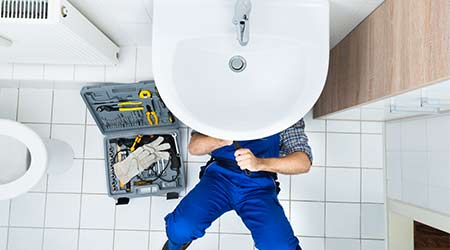 With a number of strategies at their disposal, managers overseeing aging plumbing systems no longer need to wait for an unexpectedly high water bill caused by faulty fixtures to determine that pipes and fixtures are the sources of the problem.
With a number of strategies at their disposal, managers overseeing aging plumbing systems no longer need to wait for an unexpectedly high water bill caused by faulty fixtures to determine that pipes and fixtures are the sources of the problem. Plumbing Systems: Proactive Maintenance
Managers who schedule preventive maintenance can help make sure plumbing systems perform and operate as expected.
Managers overseeing aging plumbing systems no longer need to wait for an unexpectedly high water bill caused by faulty fixtures to determine that pipes and fixtures are the sources of the problem. They have a number of strategies at their disposal.
Installing water-flow meters inline in various areas helps managers understand real-time flow rates. With a regular, frequent review of these meters as part of the scheduled PM program, managers can compare the current flow rate to a base flow rate and determine that a change has occurred and the amount of the change.
Even without inline metering, technicians can listen for the sound of continuous water flow in drains during PM inspections in order to locate the leak and eliminate the cause of the waste.
Recurring clogs or overflows can indicate a problem with the drain design. Using tee fittings or short-sweep elbows instead of 45-degree Y fittings, street 45s, or long-sweep elbows can cause drain clogs. Some drain designs have long lateral sections, and if they are longer than code or not sloped properly, they can cause frequent clogs in the lateral or eventually block the vent pipe, which also can cause clogs.
Undersized vent piping is another cause of clogs. Vents play an important role in replacing the air that rapidly leaves the piping every time water flows through a trap to the drain. Symptoms of a blocked vent include sewer odors and gurgling noises in the drain.
Installing an elbow upside down so it obstructs the flow will prevent enough air from entering the system. Not widening the vent pipe through the roof in cold climates can lead to icing as warm air condenses when meeting the cold outside air and then freezing over the smaller vent pipe opening.
Failing to slope a horizontal vent pipe toward the drain can prevent condensate from draining, causing buildup in the vent line that shuts off air flow.
Repairing leaky steam traps and collecting the condensed water are opportunities to save makeup water and water-treatment chemicals. The collected water is recycled to a condenser for boiler makeup water. Periodically, technicians must clean the condenser tubes to remove minerals on the tube walls. This process requires either chemical cleaning or mechanical cleaning — attaching cleaning equipment to each tube, cleaning it, and moving to the next tube.
The challenge is to determine the optimum frequency of cleaning that will save the most makeup water and boiler treatment chemicals. Some planners use a fixed cleaning frequency based on historical data. But steam use can vary by month, so this method results in either overcleaning or undercleaning.
A PdM approach results in improve the efficiency of the system and reduces overall costs. To facilitate this approach, managers can install pressure gauges on the inlet and outlet of the condenser. Technicians then can monitor the differential pressure between the two gauges and compare that pressure to the baseline differential pressure that was measured right after the tubes were installed or cleaned.
By comparing the decline in the differential pressure with usage, the planner can determine the optimum time, not a fixed calendar time, for cleaning. Repair histories will show a distinct cost improvement and minimal downtime using PdM.
During cleaning, some tube ferrules or bushings might require replacement if they leak. Recording the replacements on a tube map that shows the location of each tube repaired is one proven tactic for collecting data on repair frequency and labor hours.
Related Topics:














